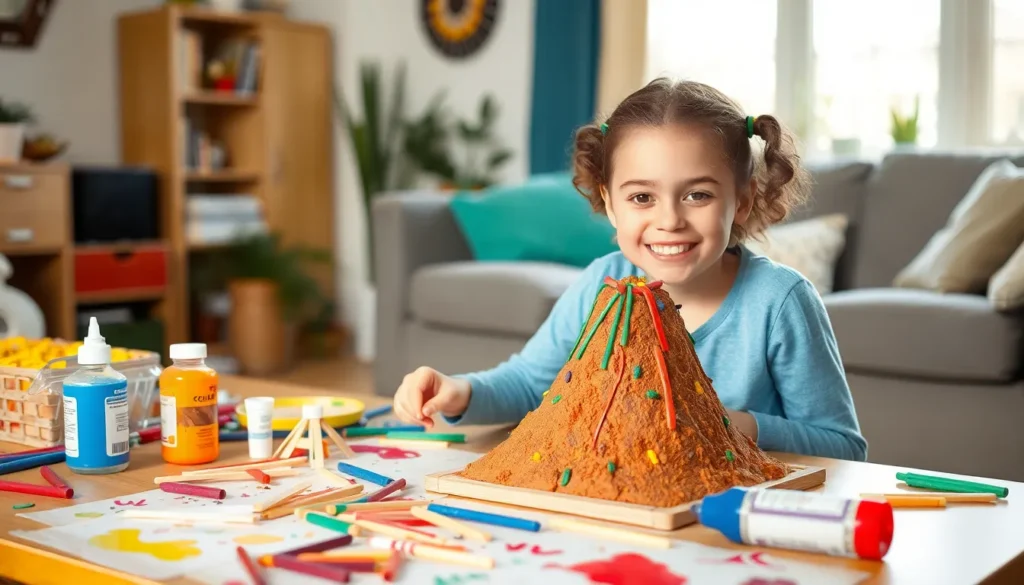Table of Contents
ToggleIn a world where screens often steal the spotlight, it’s time to bring back the magic of hands-on learning with STEM crafts for kids. These delightful projects not only spark creativity but also sneak in some science, technology, engineering, and math lessons without the kids even realizing it. Who knew building a volcano could teach about chemical reactions while doubling as an epic mess?
Parents and educators alike are discovering that STEM crafts are the perfect antidote to boredom. Whether it’s creating a rocket from recycled materials or designing a simple circuit, these activities transform ordinary afternoons into extraordinary adventures. So grab those craft supplies and get ready to watch little minds light up with curiosity and joy. After all, who wouldn’t want to be the coolest adult on the block with a DIY robot army?
Overview of STEM Crafts for Kids
STEM crafts for kids combine educational principles with hands-on activities. They encourage young learners to explore science, technology, engineering, and math concepts in a playful manner. Engaging in these projects promotes critical thinking, creativity, and problem-solving skills.
Building structures from everyday materials exemplifies how these crafts work. A simple task like constructing a bridge using popsicle sticks teaches kids about engineering principles while providing a fun challenge. Creating a model volcano introduces basic chemistry concepts as children observe reactions between baking soda and vinegar.
Parents and educators can easily facilitate these projects at home or in classrooms. Materials often include common household items, making it accessible and budget-friendly. Fun experiments, like designing a rocket from plastic bottles, inspire curiosity and make learning enjoyable.
STEM crafts serve as effective tools to combat boredom. They captivate children’s interests, turning ordinary moments into memorable learning experiences. Frequent participation in these activities fosters a love for learning and exploration in kids.
Utilizing online resources can enhance projects. Websites and platforms offer numerous ideas and guidelines for STEM crafts, catering to various age groups and skill levels. Such resources can streamline planning, ensuring that each project aligns with educational goals.
Ultimately, incorporating STEM crafts into routines provides significant benefits. Parents and educators can nurture essential skills, spark imaginations, and develop knowledge that lasts well beyond childhood.
Benefits of STEM Crafts
STEM crafts provide numerous advantages for children, enhancing both educational and personal development. These projects serve as a foundation for various skills that are essential in today’s world.
Enhancing Problem-Solving Skills
STEM crafts engage kids in hands-on activities that promote critical thinking. They often require kids to design, build, and test their creations. When mistakes occur, children learn to assess the problem and try new approaches. For instance, constructing a bridge using household items challenges them to think through structural integrity. These experiences help develop resilience and adaptability. Finding solutions fosters a growth mindset, equipping children with skills that extend beyond crafting. Participating in these activities cultivates a proactive attitude towards challenges in real life.
Fostering Creativity and Imagination
Creativity flourishes in an environment where children can experiment without constraints. STEM crafts encourage exploration and innovation, allowing kids to express their unique ideas. Building a model ecosystem or designing a solar oven invites imaginative thinking. They can personalize projects based on interests, leading to ownership and satisfaction. Engaging in creative processes also enhances cognitive flexibility, as children must navigate different materials and concepts. Activities that center on creating provide a perfect platform for artistic expression, blending science with creativity. Overall, the integration of imagination in STEM crafts nurtures a lifelong appreciation for learning and artistic exploration.
Popular STEM Crafts for Kids
STEM crafts engage children’s minds while introducing them to scientific concepts. Creative projects promote learning through fun experiences.
DIY Science Experiments
DIY science experiments provide hands-on learning opportunities. Kids can create a homemade volcano using baking soda and vinegar, which demonstrates chemical reactions. Building a simple circuit with a battery, wires, and a light bulb teaches basic electronics. Growing crystals using sugar or salt offers insights into biology and chemistry. Projects like these inspire curiosity and foster critical thinking skills.
Engineering Challenges
Engineering challenges encourage problem-solving and design thinking. Constructing a bridge from popsicle sticks allows kids to explore stability and weight distribution. Designing a catapult using rubber bands and spoons illustrates the principles of mechanics. Building a roller coaster from foam pipes or marbles emphasizes concepts like gravity and motion. Each activity promotes creativity while reinforcing engineering fundamentals.
Technology-Based Projects
Technology-based projects introduce children to coding and robotics. Building a simple game using block-coding platforms enhances logical thinking. Creating a stop-motion animation with a smartphone combines art and technology, fostering creativity. Kids can develop a basic robot using simple kits that teach coding principles. Engaging in these projects enhances technical skills while sparking an interest in future technological innovations.
Tips for Successfully Engaging Kids in STEM Crafts
Engaging kids in STEM crafts involves thoughtful planning and a nurturing approach. Implementing practical tips enhances the learning experience while keeping enthusiasm high.
Choosing Age-Appropriate Projects
Select projects that align with kids’ developmental stages. Younger children respond well to simple tasks, like building a paper rocket, which introduces fundamental principles. For older kids, consider more complex challenges, such as designing a solar oven. Assess skill levels accurately to encourage confidence. Avoid overwhelming tasks that might discourage participation. Divide larger projects into manageable steps, making the process less daunting. Aim for activities that captivate interest and spark curiosity about science and technology.
Creating a Safe Crafting Environment
Establish a designated crafting space that promotes safety and creativity. Keep appropriate tools and materials organized and easily accessible. Supervise children during activities, particularly when using scissors or adhesives. Encourage the use of non-toxic supplies to ensure safety during crafting. Set clear guidelines for handling materials to minimize accidents. Foster an environment where kids feel comfortable experimenting with ideas. Finally, always keep first aid supplies within reach for unexpected minor injuries.
Conclusion
STEM crafts offer an exciting avenue for children to explore and learn. By engaging in hands-on activities, kids develop critical thinking and problem-solving skills while nurturing their creativity. These projects not only combat boredom but also inspire curiosity and a love for learning.
Parents and educators can easily incorporate STEM crafts into daily routines, turning ordinary moments into extraordinary learning experiences. With accessible materials and a bit of planning, anyone can create a nurturing environment that encourages experimentation and self-expression. Embracing these crafts can truly make a lasting impact on a child’s educational journey, equipping them with essential skills for the future.








